By Jeffrey A. Rendall, Photos by Kevin Gaydosh
DURHAM, NC – I think you’ll agree, one of the best things about American colleges and universities is their unique mascots. When you hear “Wolverines,” you think Michigan. When you hear “Ducks,” you think Oregon. And when you hear “Blue Devils,” you think Duke.
That’s the thought we carried into a visit to the Duke University Golf Club, and we knew the Blue Devil moniker would mean certain things to a golfer – most specifically, high quality and attention to detail. Duke has earned a reputation as one of America’s finest universities, and its golf club certainly adds to the character.
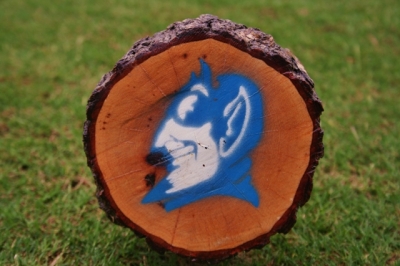 |
| One glance at the tee markers and you will know exactly where you are. |
An original Robert Trent Jones design that was renovated by his son Rees, Duke offers a thrilling ride through undulating terrain just a few miles from downtown Durham on the Duke University west campus where the Duke Chapel is located. And although gaining admission into the University is challenging at best, the golf course is very accessible to the golfing public.
Rees Jones tells how his family became involved with the Duke Golf Club: “The course was built in the late 50’s, opening in 1957. I wasn’t involved with the initial design, but played the NCAA Championship for Yale on the Duke Course in 1962 – the year Kermit Zarley won.”
“That was my first publicity as a son playing his father’s design,” Jones remembered, adding that any “tips” he might have received from his famous father didn’t do him any good while playing in the tournament.
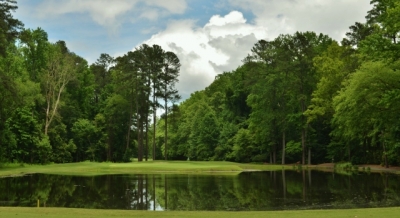 |
| The par three 12th hole. Enough said. |
Rees then came back in the early 90’s to redo the course. “It basically involved rebuilding the whole golf course – new bunkers, greens, tees. We utilized the same routing. I kiddingly said that I changed every green that I three-putted… I couldn’t remember which ones I did, so I changed ‘em all.”
It’s true, the primary reason for the redo involved the greens. Like many of the courses Rees has renovated for his father, Duke lacked putting surfaces that met USGA standards. Bentgrass can’t survive on push-up greens, so they needed to be rebuilt to support the latest grasses (and hence, faster and smoother rolling surfaces).
“We essentially just rebuilt the course with more money,” Rees lectured. “Dad didn’t have as much financial backing at that course that I got. Like at Congressional, Golden Horseshoe Gold, Atlanta Athletic Club… he didn’t have a lot of money to do the fairway grading back then. You had to have greens, and you have to have tees.”
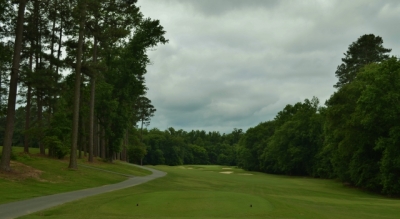 |
| The 395-yard 3rd hole looks benign from the tee, but all the trouble is around the green. |
“In fact, Duke had no fairway bunkers when he did it because they couldn’t afford to build the bunkers. So basically, I did all the grading, did some drainage work, rebuilt all the greens and put in the fairway bunkers and re-positioned the greenside bunkers so they came into play more. I basically finished the golf course for my Dad,” Rees said.
The “finished” product is definitely worthy of praise. It turns out that the university first envisioned building a golf course way back in the 30’s – only to be postponed during World War II. The property that the course now occupies was chosen for its unique blend of unusual elevation changes throughout its mildly rolling terrain.
The site typifies the Piedmont of North Carolina at its best, sprinkled with meandering streams and blessed with a variety of hardwoods, towering pines and beautiful shrubbery.
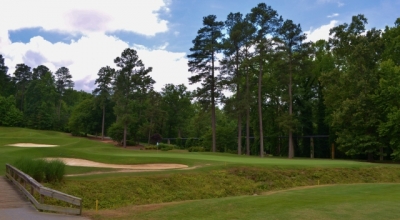 |
| Not really visible from this angle, but the green of the par five 11th has an "S" shape. |
The Duke course is definitely one that’s notable for its beauty as well as its playing character. Ed Ibarguen (Duke’s General Manager) gives much of the credit to Rees Jones: “It would be difficult to describe the loving care that Rees Jones puts into the design of each and every golf course feature. He is a demanding perfectionist who insists that future playability of his work be held at a premium.”
Ibarguen continues, “Throughout the redesign, Rees scrutinized every shot possibility, observed and considered every angle so as to insure that each nuance of the golf course would be subtle, yet perfectly placed.”
High praise, indeed. For his part, Rees gives just as much credit to Ibarguen for the success at Duke, as Ibarguen was in charge of the 5-year master plan for bringing the course back up to standards worthy of the university.
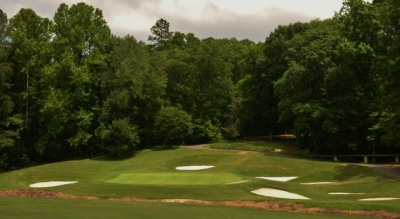 |
| The par five 7th is a three-shot hole for all but the longest hitters due to the creek running in front of the green. |
One of the many things we enjoyed about the course was its perfect mix of playability and challenge. Ibarguen describes the latter: “The holes wind beautifully through the Duke Forest and wayward shots can be gobbled up in the natural setting found beyond the rough on every hole.”
“Although generous off the tee, the shot values into the greens are demanding. A purposefully designed golf course management jewel. It requires you to stay focused in order to move your ball around the golf course in a skillful, chess-like manner, lest you end up with a silly bogey or often, much worse,” Ibarguen concluded.
Chess is a good way to describe it. Very much a golf course in the old style, there are plenty of doglegs, uphill shots, downhill shots – and even sidehill shots. Yet the holes are more than wide enough to accommodate horizontally challenged average golfers, especially from the forward sets of tees. There’s water on the course, yet not employed in a menacing manner.
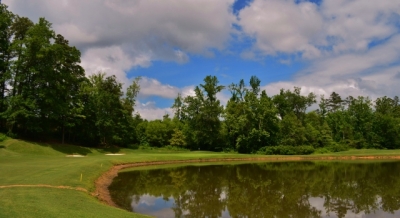 |
| Bailout to the left if you do not want to challenge the water on the par four 13th. |
In other words, you won’t lose a dozen balls here – unless you really get wild.
Duke’s course is also extremely walker-friendly, with tees conveniently located near the previous hole’s green. It’s quite a throwback to the old days when you would go to the course and expect to hoof-it for a few hours.
Ibarguen takes us through the highlight holes (all yardages from the Championship tees):
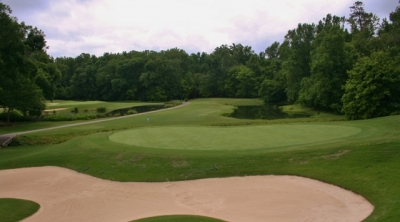 |
| Looking from behind the 4th green. The serenity is tangible. |
“Hole #3: Par 4 / 395 yards. This is an exacting par four which calls for a chess move off the tee. A straight approach to the throat of this small, shielded green is possible if you are willing to flirt with the right side fairway bunker on your drive.
“The left side is the safer route but it will leave you with a line that requires playing between bunkers short and water long. Either choice is challenging on this blue-ribbon hole.”
“Hole #7: Par 5 / 580 yards. Here's your shot at our first par five but don't celebrate too early—it’s a brute. A prodigious driving hole where your best 300 yard drive can fly over the right side fairway bunkers leaving you a mere 272 into the green! For most of us, choices on the second are limited due to the creek crossing only seven yards from the front of the green.
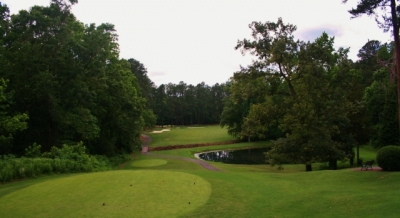 |
| Trees encroach from the right off the tee of the par four 16th hole. |
“Good news, if you can carry the green there's plenty of room long. Bad news, the real challenge is in putting this uniquely sculptured green that slopes strongly from back to front. Shots that end up above the hole will require the deft touch of one of our Duke Medical Center surgeons.”
“Hole #11: Par 5 / 573 yards. A strategic hole featuring a slippery green design that is shaped into an "S" and literally painted into its surrounding landscape. A player's attitude and psyche will be molded by this critical turning point hole. This is the beginning of Duke's own "Amen Corner."
“This hole can be reached in two if one smashes their tee shot long and left near the fairway bunker. Before you play your second, you should consider where you will approach the cunning design of this short right to long left green protected by Sandy Creek in front and bunkers on both sides. Regardless of your result, this hole is a golfer's delight.”
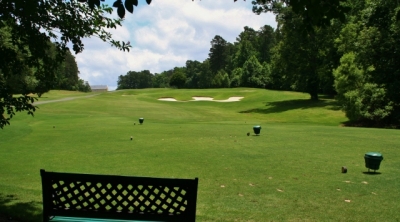 |
| If you have a moment, take a seat on the bench after you hit your tee shot to the par three 8th hole. |
“Hole #12: Par 3 / 181 yards. Playing further into the 'Corner,' we arrive at one of Duke's photographic gems. You'll love this showpiece three par from any tee position. If you're playing the back ‘Devil’ tees, Rees has provided you with a peninsula green that provides challenge as well as aesthetics. It is a singular opportunity to prove your mettle. This hole confirms the fact that water has an uncanny ability to collect all those shots hit with hope rather than confidence.”
“Hole #16: Par 4 / 402 yards. This inviting four par allows you a moment to enjoy the visual beauty and panorama from the Devil tee which is located on the highest point of the golf course. Any of the elevated tee boxes will give your drive extra carry as you try to land far enough into the dogleg to see the green.
“The short grass is lined with hanging hardwoods on the right and a series of fairway bunkers left and long. Your uphill second is played to a wide green divided by a sloping ridge. Care should be given to selecting enough club to carry the large front bunker that has been placed to gather your mishit iron.”
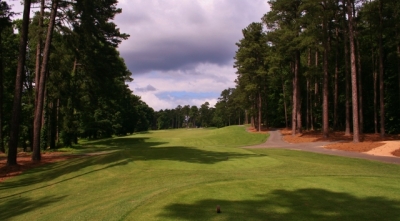 |
| The long and challenging par four 17th is probably the most difficult hole on the Duke course. |
“Hole #17: Par 4 / 439 yards. Per the Robert Trent Jones Sr. design philosophy, the designer should plan to take a player effortlessly through their entire bag of clubs through 16 holes. Then, with two holes left to play, the course demands a little extra to complete the championship golf experience.
“Rees has continued in this classic tradition with his design of the seventeenth at Duke. A taxing driving hole, straight away but more, asking for both length and accuracy. Any tee shot other than long and straight will leave you with a real test of your long iron ability. Greenside bunkering creates additional hardship making this the most difficult hole on the course. Par is a good score.”
Rees Jones confirmed that the final two holes are meant to be tough – that’s part of his dad’s philosophy. If you’ve played enough Robert Trent Jones courses, you know the finish will demand length and accuracy from tee to green. You’ll earn your score, that’s for sure.
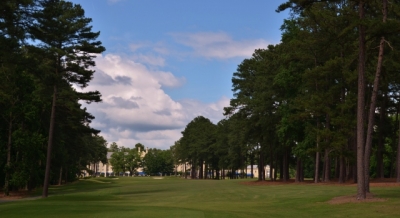 |
| Coming home, the 455-yard, par four 18th will demand a solid drive and second shot to finish the round well. |
As for Duke’s place in the golfing universe, Rees says it’s going to be characteristic of the type of course we’ll see more and more: “Personally, I think Duke is a course with a future. I think we’re going to de-emphasize length now.”
“I think having all the par fives being reachable in two is kind of fun for a university course. These kids don’t have as much time to play, but they do hit the long shots.”
That’s also true. Modern equipment allows everyone to hit it longer – and Duke provides the opportunity to use that length in a strategic way.
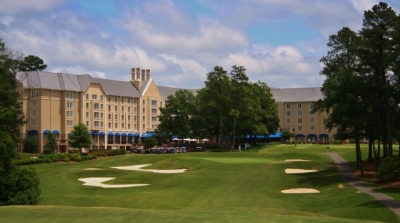 |
| At 493-yards, the par five 9th is reachable in two - especially if you hug the left side of the fairway off the tee. The Washington Duke Inn provides the backdrop, too. |
All in all, a very fine golf experience, one that makes you truly feel like a Blue Devil for a day.
Note: The golf course is located next to the four diamond, 271 guest rooms and suites, Washington Duke Inn. The Inn has a Conference Center that features 20 elegant meeting rooms and contains 7,600 square feet of luxurious event space.
We particularly enjoyed the bar after the round, and look forward to visiting again.
 |
Where we Stayed
The Hilton Garden Inn Durham Southpoint hotel is conveniently located off I-40 and within close proximity to Durham, Chapel Hill and RDU International Airport. Across from The Streets at Southpoint mall, the hotel is loaded with amenities for the comfort of all guests. Its rooms are furnished with a spacious work desk and Herman Miller Mirra® ergonomic desk chair, two phones, voicemail and complimentary wired and wireless high-speed internet access.
Standard in every room is a 32-inch LCD HD TV, along with a hospitality center complete with microwave, refrigerator and coffee maker. Call 919-544-6000 or visit http://hiltongardeninn3.hilton.com/en/hotels/north-carolina/hilton-garden-inn-durham-southpoint-RDUSPGI/index.htm
Note: We would especially like to commend the staff at the hotel, which went out of their way on several occasions to make our stay comfortable and relaxing. When combined with the hotel’s central location to a number of great courses in the Triangle area, it’s an excellent place to stay for golfers visiting North Carolina. Summit Hospitality owns and operates 15 hotels in the Triangle, Charlotte, Pinehurst and Wilmington as a franchisee of Marriott, Hilton and Hyatt brands. It also offers golf packages at various properties. www.SummitHospitality.com
Details:
Duke University Golf Club
3001 Cameron Blvd.
Durham, NC 27705
Website: golf.duke.edu or washingtondukeinn.com
Designers: Robert Trent Jones, Rees Jones
General Manager: Ed Ibarguen, PGA
Tees/Yardage/Slope/Rating
Championship 7154 73.9/141
Gold 6872 72.6/135
Blue 6562 70.9/129
White 6127 69.6/122
Green 5288 66.6/118 72.2/126 (W)
Rates:
Monday-Thursday: 7am-1:20pm = $55 walking, 1:30pm-4:20pm = $50 walking, After 4:30pm = $30 walking.
Callaway Rental Clubs always available for our guests.
| Related Links | Comments on this article? | |
|
Maryland National Golf Club Hollow Creek Golf Club Rocky Gap Resort PB Dye Golf Club in Ijamsville Whiskey Creek Golf Club |
E-mail Jeff Rendall, Editor: jrendall@golftheunitedstates.com |












